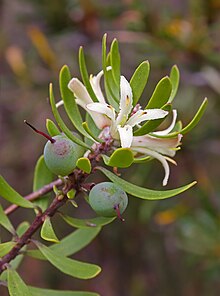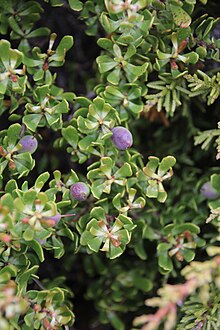Persoonia gunnii is a species of flowering plant in the family Proteaceae and is endemic to Tasmania. It is an erect shrub with young branchlets that are hairy at first, spatula-shaped to egg-shaped leaves with the narrower end towards the base, and white to cream-coloured flowers.
| Persoonia gunnii | |
|---|---|

| |
| In Mount Field National Park | |
| Scientific classification | |
| Kingdom: | Plantae |
| Clade: | Tracheophytes |
| Clade: | Angiosperms |
| Clade: | Eudicots |
| Order: | Proteales |
| Family: | Proteaceae |
| Genus: | Persoonia |
| Species: | P. gunnii
|
| Binomial name | |
| Persoonia gunnii | |

| |
| Occurrence data from Australasian Virtual Herbarium | |
| Synonyms[1] | |

Description
editPersoonia gunnii is an erect shrub that typically grows to a height of 0.65–3 m (2 ft 2 in – 9 ft 10 in) with its young branchlets covered with erect, whitish or greyish hairs. The leaves are spatula-shaped to egg-shaped with the narrower end towards the base, 10–50 mm (0.39–1.97 in) long, 3–10 mm (0.12–0.39 in) wide and upcurved with an erect tip. The flowers are erect on hairy pedicels 2.5–5 mm (0.098–0.197 in) long, the tepals white to cream-coloured, 10–13.5 mm (0.39–0.53 in) long and hairy on the outside, apart from the glabrous tip. Flowering occurs from December to May. The species is sometimes confused with P. muelleri.[2][3][4]
Taxonomy
editPersoonia gunnii was first formally described in 1847 by the English botanist Joseph Dalton Hooker in W.D. Hooker's London Journal of Botany from specimens collected on the "May-day Plains" by R.C. Gunn.[5][6]
Populations with characteristics intermediate between P. gunnii and P. muelleri are known from Dove Lake–Cradle Mountain and Adamsons Peak–South Cape localities. Further intermediates with P. muelleri subspecies angustifolia have been recorded from Adamsons Peak, the South Cape Range and the Recherche Bay area in southern Tasmania, but further work is needed to assess their status.[2][3]
Distribution and habitat
editThis geebung is endemic to Tasmania where it is found to the south and west of Black Bluff Range–Lake St Clair and the Derwent River at altitudes from 500 to 1,300 m (1,600 to 4,300 ft) above sea level. Habitats include alpine heathland, subalpine wet sclerophyll forest and rainforest, on soils composed of and lying over dolerite, quartzite and limestone.[2][3]
Ecology
editPersoonia gunnii is highly sensitive to dieback.[7]
References
edit- ^ a b "Persoonia gunnii". Australian Plant Census. Retrieved 15 October 2020.
- ^ a b c "Persoonia gunnii Hook.f." Flora of Australia Online. Department of the Environment and Heritage, Australian Government.
- ^ a b c Weston, Peter H. "Persoonia gunnii". Australian Biological Resources Study, Department of Agriculture, Water and the Environment: Canberra. Retrieved 16 October 2020.
- ^ Jordan, Greg. "Persoonia gunnii". University of Tasmania. Retrieved 16 October 2020.
- ^ "Persoonia gunnii". APNI. Retrieved 16 October 2020.
- ^ Hooker, Joseph D.; Hooker, William J. (ed.) (1847). "Florae Tasmaniae Spicilegium: or, Contributions towards a Flora of Van Diemen's Land". London Journal of Botany. 6: 283. Retrieved 16 October 2020.
{{cite journal}}:|first2=has generic name (help) - ^ Rudman, Tim; Balmer, Jayne (2007). "Death on the Moor: The Impact of Phytophthora cinnamomi on Buttongrass Moorland". Australasian Plant Conservation. 16 (3): 29–31. ISSN 1039-6500.